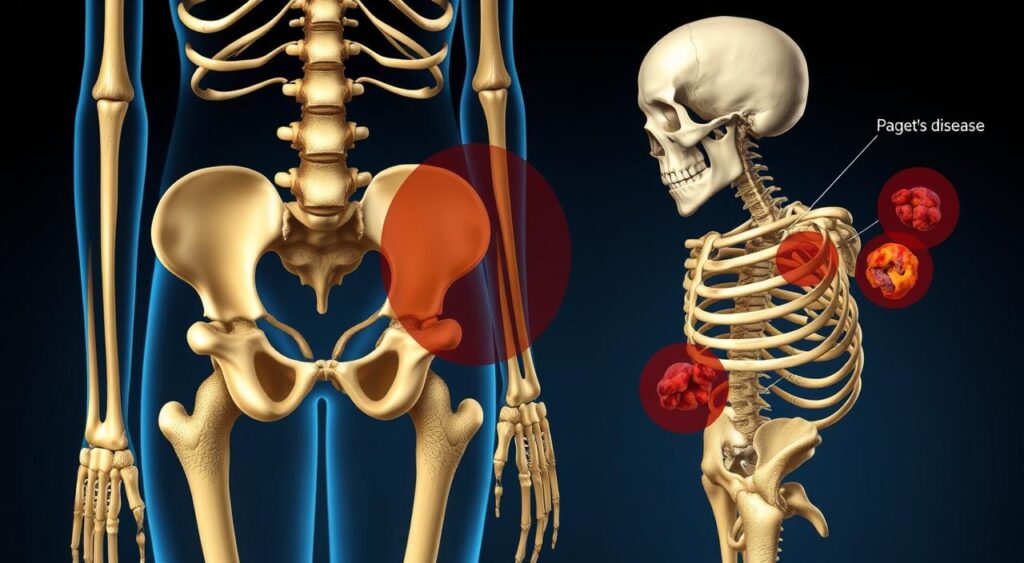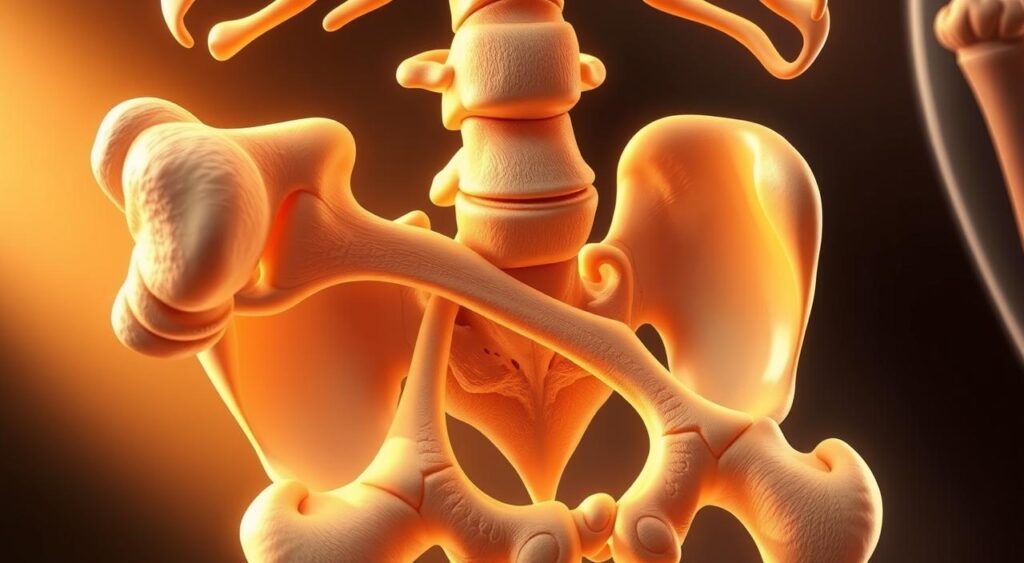Get the inside scoop on Paget’s disease. Our comprehensive guide covers causes, symptoms, and effective treatment approaches.
Paget’s disease: It’s a chronic bone disorder that messes with bone remodeling. This leads to weak and misshapen bones. Knowing about Paget’s disease is key for early detection and managing it well.

Paget’s disease makes the body break down and rebuild bone tissue too fast. This can make bones bigger, softer, and more likely to break. The exact cause is still a mystery, but genetics and environmental factors might be involved. Spotting symptoms early and getting treatment can greatly help manage the condition.
Key Takeaways
- Paget’s disease affects bone remodeling, leading to abnormal bone growth.
- It is more common in individuals over the age of 55.
- Early detection can help manage symptoms effectively.
- Genetics and environmental factors may contribute to its development.
- Treatment options include medications, surgery, and lifestyle changes.
Understanding Paget’s Disease
Paget’s Disease is a chronic bone disorder that disrupts the normal recycling process of bone tissue. This condition leads to weakened bones, deformities, and other complications. Recognizing paget’s disease symptoms early can help manage the condition effectively.
Definition and Basic Concept
Paget’s Disease occurs when the body’s bone remodeling process becomes imbalanced. New bone forms faster than old bone is removed, resulting in brittle and misshapen bones. Common symptoms include bone pain, fractures, and joint stiffness.
Types of Paget’s Disease
There are several types of Paget’s Disease, each affecting different parts of the body. The most common form is osteitis deformans, which primarily impacts the pelvis, spine, and skull. Other types may target specific bones, leading to localized symptoms such as swelling or warmth in the affected area.
Who Is Most Affected?
Paget’s Disease is more prevalent in individuals over the age of 50. It is also more common in people of European descent. While the exact cause is unknown, genetics and environmental factors may play a role. Early detection of symptoms can improve quality of life and reduce complications.
The History and Discovery of Paget’s Disease
Paget’s Disease was first found in 1877 by Sir James Paget, a famous British surgeon. He described it as a long-term disorder that affects how bones are remade. This led to bones growing too big and not in the right shape.
At first, people thought it was rare. But, with better medical tools, we now know it’s more common, especially in older people. Studies have found out what causes it, helping to find better treatments.
“The bones, though larger, are weaker and more prone to fractures,” noted Sir James Paget in his seminal work.
Now, treatments aim to ease symptoms and slow the disease’s growth. Doctors use medicines like bisphosphonates and surgery for serious cases. Physical therapy is also used. These steps have greatly helped patients.
From its start to today, learning about Paget’s Disease shows how far medicine has come. More research is needed to find even better ways to treat it.
Common Causes and Risk Factors
Paget’s Disease is a complex condition. It is influenced by genetics and the environment. Understanding these factors helps in early diagnosis and management. Knowing the risk factors is key for those at higher risk.
Genetic Components
Family history is a big factor in Paget’s Disease. People with a family history are more likely to get it. Certain genetic mutations, like in the SQSTM1 gene, are linked to the disease.
These mutations can disrupt bone remodeling. This leads to the symptoms of Paget’s Disease.
Environmental Factors
Exposure to certain toxins may raise the risk of Paget’s Disease. Studies show that heavy metals or viral infections can cause abnormal bone growth. While not definitive, these factors stress the need for a thorough diagnosis.
Age-Related Considerations
Age is a major risk factor for Paget’s Disease. Most cases are found in people over 50. The risk grows with age.
This trend highlights the importance of regular bone health checks. Especially for those with a family history. Early detection leads to better treatment and outcomes.
Recognizing the Signs and Symptoms
Paget’s disease can cause different symptoms based on how severe it is and which bones are affected. Spotting these signs early is key to managing and treating the disease. Common symptoms include persistent bone pain that feels deep and aching.
This pain usually happens in specific areas like the spine, pelvis, or legs.
Other symptoms include bone deformities, like bowed legs or an enlarged skull. Limited mobility is also common, as the disease can make it hard to move joints. Sometimes, Paget’s disease leads to fractures, osteoarthritis, or even hearing loss if the skull is affected.
- Bone pain: Often deep and localized
- Deformities: Bowing of legs or enlarged skull
- Limited mobility: Difficulty moving affected joints
- Complications: Fractures, osteoarthritis, hearing loss
If you notice any of these symptoms, see a healthcare professional right away. Early diagnosis and treatment can help manage the disease and prevent complications. Knowing the causes of Paget’s disease and spotting symptoms early can greatly improve your life quality.
How Paget’s Disease Affects Your Body
Understanding Paget’s disease is key to managing it. It disrupts bone remodeling, making bones weak and deformed. This can cause pain, mobility issues, and other problems.
Impact on Bone Structure
Paget’s disease makes bones larger and weaker. It can cause deformities like bowed legs or an enlarged skull. Bones are also more likely to break, making management crucial to prevent damage.
Effects on Joint Function
Paget’s disease can lead to osteoarthritis in bones near joints. This causes pain, stiffness, and less mobility. Proper management can help reduce these symptoms and improve joint function.
Associated Health Complications
Paget’s disease can also cause other health issues. These include kidney stones from high calcium levels and, rarely, osteosarcoma, a bone cancer. Early diagnosis and effective management are vital to reduce these risks.
Diagnosis Methods and Testing
Diagnosing Paget’s Disease requires a few steps to confirm it and see how severe it is. Finding it early is key to managing it well. A doctor will first do a physical check-up and look at your medical history.

- X-rays: These images show bone problems like thickening or shape changes, which are signs of Paget’s Disease.
- Bone scans: This test finds where the bone is most active, showing where the disease is.
- Blood tests: High levels of alkaline phosphatase (ALP) in the blood often mean Paget’s Disease.
Getting a correct diagnosis is vital for making a treatment plan. It helps improve the paget’s disease prognosis. Doctors might suggest regular check-ups and tests to keep track of the disease and change treatments if needed.
Treatment Options and Medical Interventions
Managing Paget’s Disease requires a mix of treatments. The aim is to ease symptoms, slow the disease, and prevent complications. Treatment plans include medicines, surgery, and alternative therapies to enhance life quality.
Medication Options
Medicines are often the first choice. Bisphosphonates, like alendronate and zoledronic acid, help bones heal. Pain relievers, such as acetaminophen or NSAIDs, can ease discomfort. Sometimes, calcitonin is used to control bone metabolism.
Surgical Treatments
Surgery is needed for severe deformities or fractures. Osteotomy corrects bone alignment, and joint replacement improves mobility. Surgery can also fix complications like nerve compression or spinal stenosis.
Alternative Therapies
Non-invasive methods can help too. Physical therapy strengthens muscles and improves flexibility. Techniques like acupuncture or massage can also help with pain. Eating right, with enough calcium and vitamin D, supports bone health.
Combining these treatments helps manage Paget’s Disease. Regular check-ups and a tailored care plan are key for success.
Living with Paget’s Disease: Lifestyle Adjustments
Living with Paget’s Disease means making lifestyle changes to manage symptoms. There’s no cure, but treatment and management can slow the disease. This helps reduce complications and improve your quality of life.

- Diet: Eat foods rich in calcium and vitamin D to support your bones. Include dairy, leafy greens, and fortified products in your meals.
- Exercise: Do low-impact activities like walking or swimming. These strengthen bones and improve joint function without stress.
- Stress Management: Use yoga or meditation to reduce stress. Stress can make symptoms worse.
It’s crucial to work closely with your healthcare team. They can create a personalized plan for you. This plan will include medication, physical therapy, and lifestyle changes. Regular check-ups are key to keeping your management strategy on track.
“Small, consistent changes in daily habits can make a big difference in managing Paget’s Disease.”
By making these adjustments, you can manage your health and live a fulfilling life. Despite the challenges of Paget’s Disease, you can stay in control.
Prevention and Risk Management Strategies
While we can’t always prevent Paget’s disease, there are steps to manage risks and keep bones healthy. Knowing about early diagnosis and prognosis is key. Here are some ways to lower the risk of complications and live a healthier life.
Bone Health Maintenance
Keeping bones strong is crucial to avoid Paget’s disease complications. Regular exercises like walking or light strength training help. Quitting smoking and drinking too much alcohol also helps bones stay healthy.
Regular Monitoring
Regular check-ups are important for those at risk of Paget’s disease. Bone scans and blood tests can spot early signs. Finding Paget’s disease early means better treatment and a better outlook.
Dietary Considerations
Eating a diet full of calcium and vitamin D is essential for bones. Include dairy, leafy greens, and fortified cereals. If you don’t get enough, your doctor might suggest supplements.
- Calcium: Found in dairy, almonds, and broccoli.
- Vitamin D: Sunlight exposure, fatty fish, and fortified foods.
- Magnesium: Present in nuts, seeds, and whole grains.
By following these tips, you can manage your risk better and enjoy a better quality of life.
Conclusion: Managing Your Journey with Paget’s Disease
Living with paget’s disease means being proactive and well-informed. This chronic condition can be managed well with the right steps. Early diagnosis and consistent treatment are crucial to slow the disease and reduce complications.
Working closely with your healthcare team is important. They can provide care that fits your needs. Medications, physical therapy, and lifestyle changes can greatly improve your life. Regular check-ups help track your progress and tackle any new issues quickly.
Keeping your bones healthy is key. Eating a balanced diet with calcium and vitamin D, and doing weight-bearing exercises, helps your bones. Also, avoid smoking and drinking too much alcohol to lower risks.
Remember, paget’s disease doesn’t define you. With determination and the right help, you can manage your health and live a fulfilling life. Stay informed, stay active, and focus on your well-being always.
FAQ
Q: What is Paget’s Disease?
A: Paget’s Disease is a chronic bone disorder. It causes bones to break down and grow back abnormally. This leads to various symptoms and complications.
Q: What are the types of Paget’s Disease?
A: There are mainly two types of Paget’s Disease. The most common is osteitis deformans. There are also other, less common types.
Q: Who is most affected by Paget’s Disease?
A: Paget’s Disease mostly affects people over 50. It can happen to anyone, but it’s more common in certain groups.
Q: What are the common causes and risk factors of Paget’s Disease?
A: The exact cause of Paget’s Disease is still unknown. It’s thought to be a mix of genetics and environment. Age is a big risk factor, especially over 50.
Q: What are the signs and symptoms of Paget’s Disease?
A: Symptoms vary based on the disease’s severity and the bones affected. Common signs include bone pain, deformity, and limited mobility.
Q: How does Paget’s Disease affect the body?
A: Paget’s Disease can harm bone structure and joint function. This leads to deformity, pain, and mobility issues. It also raises the risk of other health problems, like kidney stones and osteosarcoma.
Q: How is Paget’s Disease diagnosed?
A: Diagnosis involves a physical exam, medical history, and tests like X-rays, bone scans, and blood tests.
Q: What are the treatment options for Paget’s Disease?
A: Treatments include medication, surgery, and alternative therapies like physical therapy and pain management. The goal is to manage symptoms, slow disease progression, and improve quality of life.
Q: How can I manage Paget’s Disease in my daily life?
A: Managing Paget’s Disease requires a holistic approach. This includes lifestyle changes, medical treatment, and ongoing monitoring. Good bone health, stress management, and working with a healthcare team can improve quality of life and reduce complications.
Q: How can I prevent or reduce the risk of Paget’s Disease?
A: Preventing Paget’s Disease is not guaranteed. However, maintaining good bone health, regular monitoring, and managing underlying conditions can lower the risk.
